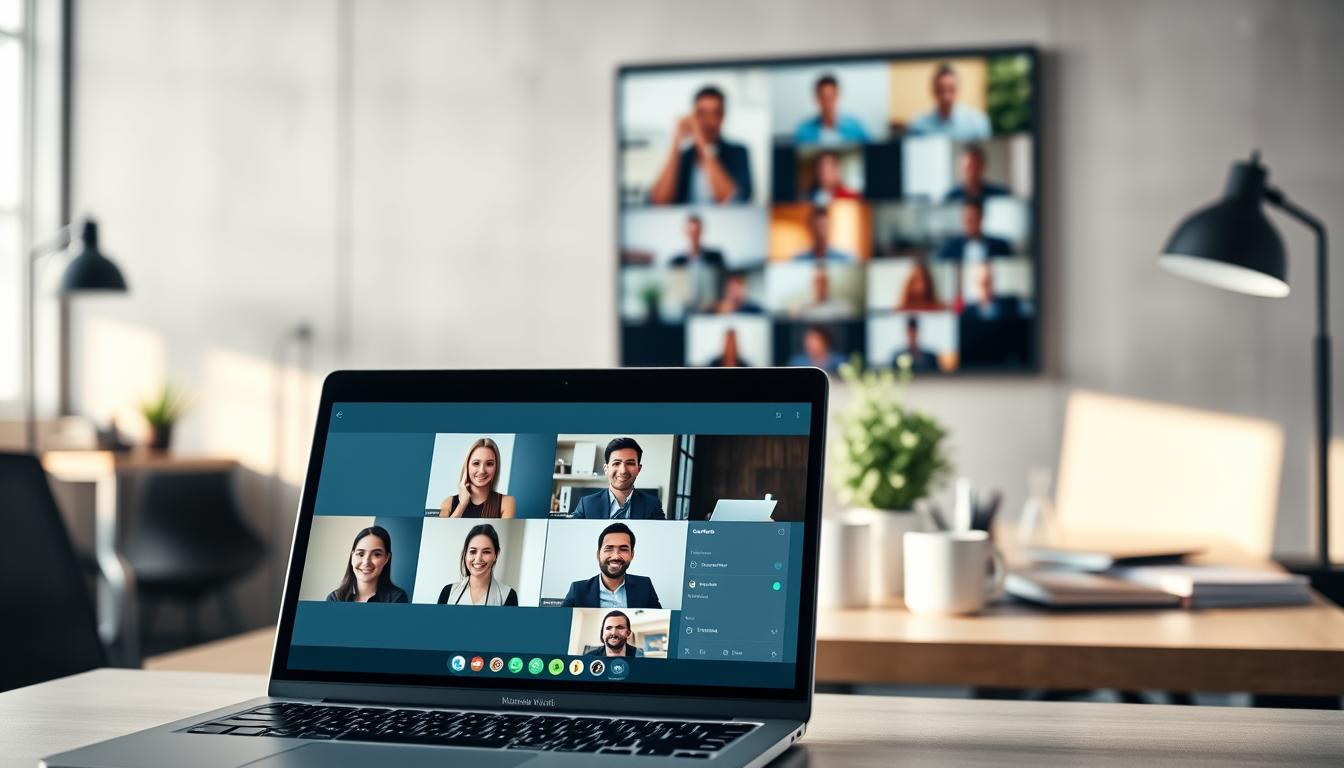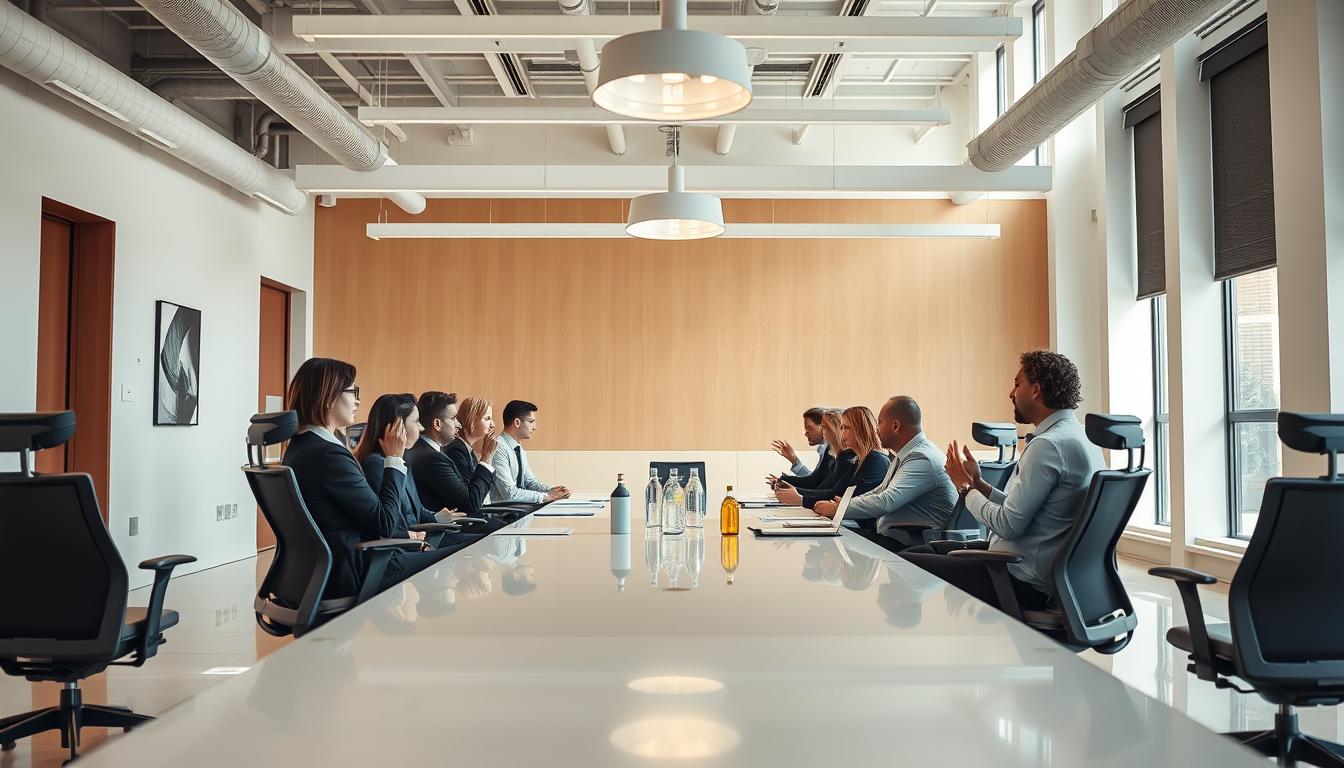In today’s world, businesses are always trying to do better and get more done. But meetings that don’t help can waste time and lower team spirit. A study by Igloo Software found that almost half the people think meetings don’t work well. This highlights the need for meetings that are really useful.
To make meetings better, it’s important to spot issues like meetings that last too long or don’t have clear goals. Teams can change how they meet by focusing on these problems. Meetings that are planned well can make people more interested. They can also make sure the time spent in meetings is worth more than the costs.
Understanding the Cost of Ineffective Meetings
Ineffective meetings can really hurt a company’s wallet. Just think, a single hour-long meeting with ten people might waste about $20,000 a year in lost work and pay. Studies show that 70% of meetings actually make employee performance worse, not better. That’s why it’s important to think hard about whether a meeting is really needed.
Companies need to see that these meetings are often just throwing resources away. They should look at how productive meetings are. Maybe what they’re meeting about could be done with an email, a report, or just a quick chat. Finding ways to avoid unnecessary meetings can save a lot of time and money.
Identifying Common Types of Unproductive Meetings
It’s key for any organization to spot unproductive meetings to boost efficiency. Many meetings don’t help and just waste time and resources. For example, really long meetings can make people tired and less focused.
If a meeting has no clear agenda, it leads to confusion. People might not know why they are there, causing discussions to go off track. This wastes a lot of time that could have been used better.
Having people in the meeting who shouldn’t be there can also be a problem. They can distract those who actually need to focus. This makes the meeting less effective and productive.
To make meetings more useful, organizations need to avoid these mistakes. Recognizing and fixing these issues can lead to more effective meetings. This way, everyone can get more done.
How to Stop Wasting Time in Meetings
To boost productivity, it’s key to check if meetings are really needed. Many times, meetings happen but don’t bring much value. This takes away time from important work. By figuring out if you truly need a meeting, you can manage time better and use resources wisely.
Assessing Meeting Necessity
Before you plan a meeting, think about if it’s truly important. Ask yourself if an email could replace it, what the meeting’s goal is, and if everyone needs to be there. This helps skip meetings that aren’t needed. It means you don’t waste time and can stay focused on main tasks. Also, having days with no meetings lets teams concentrate on what they really need to do.
Utilizing Alternatives to Meetings
Looking at other ways to share info can make teams more efficient. Using emails or written updates saves time since not everyone has to stop and meet. Quick stand-up meetings are a good way to update each other without taking too much time. These methods don’t just save time; they make teams more flexible and quick to respond.
The Importance of a Clear Agenda
A clear meeting agenda is key for good talks and smart choices. It’s like a roadmap for what needs to happen. With a solid agenda, everyone knows what the goals are. This way, meetings run smoothly and stay on point.
Creating an Agenda Template
When making an agenda, add these parts:
- Meeting title and date
- List of attendees
- Objectives of the meeting
- Discussion topics with the time for each
- What each person has to do
This setup helps everyone get ready and bring smart ideas. It’s like a path that guides the meeting.
Sharing the Agenda Ahead of Time
It’s smart to send out the agenda early. This way, people can think about the topics. They can also look up any info they might need. Knowing what’s ahead, they can come up with questions or ideas. This helps everyone get more from the meeting.
Best Practices for Meeting Length
On average, meetings last about 50.6 minutes. Yet, many can be done quicker. Short meetings of 15 or 30 minutes improve time management and focus. They keep participants engaged and make discussions more efficient.
Stand-up meetings are a great way to keep things moving. They make people stay focused and join in. This stops meetings from getting too long. It keeps things productive and meetings effective.
Teaching teams about managing time is smart. Short, well-planned meetings lead to better outcomes. So, leaders and team members should push for quick meetings. This makes sure everyone feels like they’ve achieved something and leaves informed.
Establishing Ground Rules for Meetings
To make meetings work well, it’s key to set clear rules. These rules keep things on track and help everyone talk well together. Rules like being on time, ready to go, and really joining in are crucial. When everyone knows they should arrive prepared and on time, meetings tend to go really well.
How we act in meetings is super important. It helps create a place where everyone respects and listens to each other. Making sure everyone knows how to be and what to do helps the meeting go smoothly. It lets everyone work better together.
Putting solid rules in place for meetings makes sure time is used wisely and goals are reached. Having good behavior rules makes everyone do their part. This helps the whole team reach its goals faster.
Encouraging Participation and Engagement
Making meetings engaging is key to getting great results. Having everyone involved brings more ideas and better teamwork. Leaders need strategies to keep everyone active in the conversation.
Creating an Inclusive Environment
It’s key that everyone feels important and listened to. Setting rules for respectful talk and different viewpoints is vital. When people are comfortable to speak up, the talks get way better.
A simple “thank you” for ideas or asking for opinions makes people feel part of the group. This makes everyone more willing to share.
Using Interactive Tools and Methods
Adding fun tools to meetings keeps the energy up and people involved. Digital tools and quick votes make things lively. It lets people share their thoughts and pay attention.
With new tech, meetings are more fun and useful for all. It helps everyone connect and contribute.
The Role of Meeting Facilitators
Meeting facilitators play a vital role in keeping discussions focused during meetings. They make sure everyone sticks to the agenda and that everyone has a chance to speak. This job needs strong leadership to keep conversations productive and on track.
They have several key duties:
- They get the agenda out early to let everyone know what to expect.
- They make sure everyone feels part of the discussion, creating a responsible team atmosphere.
- They keep talks relevant to make the most out of the meeting time.
- They handle any issues or off-topic chatter that might disrupt the meeting’s flow.
A good facilitator doesn’t just keep order; they also inspire everyone to join in. With their expertise in running meetings, they can turn regular gatherings into productive and lively sessions with real results.
Post-Meeting Follow-Up and Accountability
After a meeting, it’s key to follow up. This makes sure that talk turns into real action. By going over the meeting’s main points, what needs to be done, who will do it, and when, teams keep their eyes on the prize.
Following up well makes everyone accountable. When tasks are clearly given out, each person knows what they should do. This clears up any confusion and pushes people to finish their tasks in time.
Tools like emails or project management software help keep track of promises made. These methods make it easier to see who’s doing what and by when. This way, teams can move forward, completing goals as planned.

Techniques to Minimize Distractions During Meetings
Creating a space without distractions is key to better focus in meetings. Effective strategies can really help cut down on distractions. This makes meetings more productive.
Having a no-phone policy cuts down on interruptions. Ask everyone to mute their phones or leave them outside. Picking quiet spots for meetings also helps avoid noise from outside.
Making sure everyone is actively taking part helps keep attention high. If people feel involved, they stay more focused. Use interactive tools like polls or brainstorming to keep everyone’s interest.
It’s critical to set rules around multitasking. Ask everyone to stay fully engaged in the conversation. This avoids distractions like web surfing or checking emails, leading to better focus.
Conclusion
To save time from unproductive meetings, we need to work together and use effective strategies. By checking if a meeting is needed and making clear agendas, we can change how we meet. This approach saves time and makes everyone responsible.
By getting everyone involved, our meetings can lead to better discussions and success. Structured meetings let employees focus on more important work, boosting productivity. Moving to this dynamic meeting style benefits everyone.
Choosing efficient meetings and trying new strategies helps build a better workplace. It leads to a strong culture that values time and hard work. Making meetings more effective paves the way for success.



